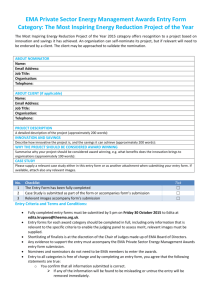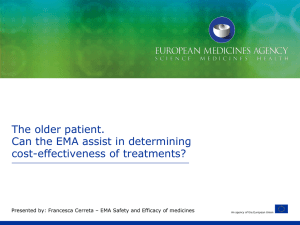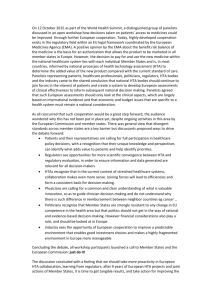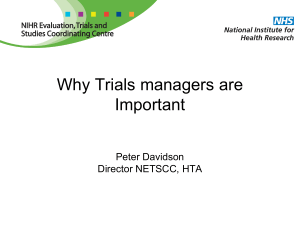Guidance for companies considering the adaptive pathways approach
advertisement
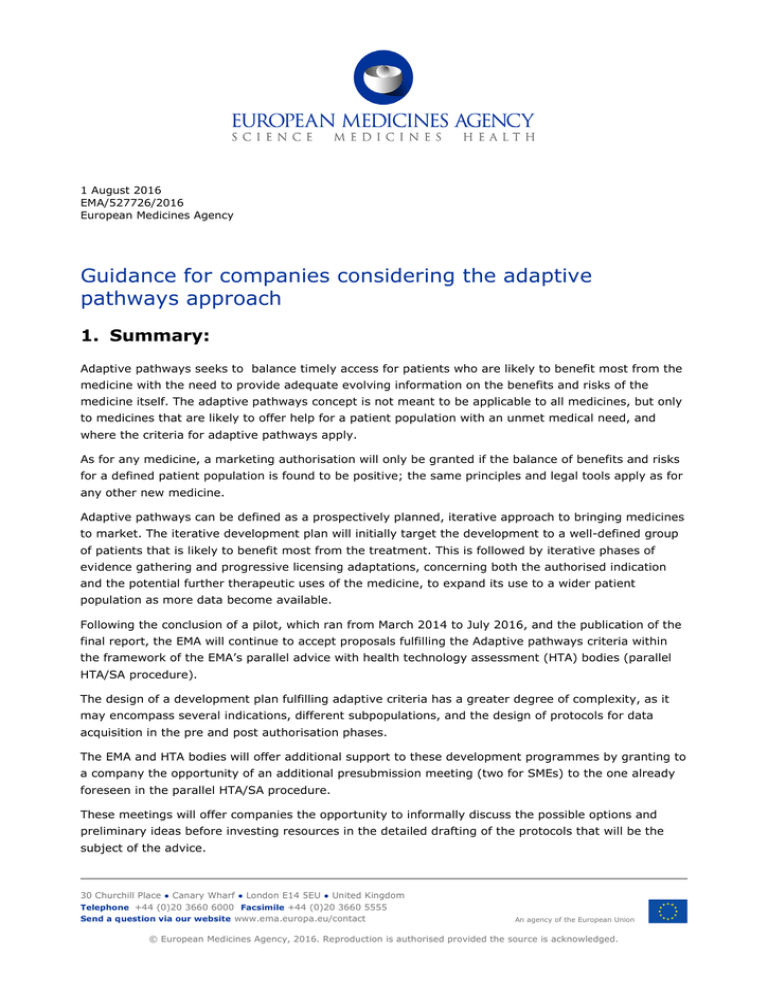
1 August 2016 EMA/527726/2016 European Medicines Agency Guidance for companies considering the adaptive pathways approach 1. Summary: Adaptive pathways seeks to balance timely access for patients who are likely to benefit most from the medicine with the need to provide adequate evolving information on the benefits and risks of the medicine itself. The adaptive pathways concept is not meant to be applicable to all medicines, but only to medicines that are likely to offer help for a patient population with an unmet medical need, and where the criteria for adaptive pathways apply. As for any medicine, a marketing authorisation will only be granted if the balance of benefits and risks for a defined patient population is found to be positive; the same principles and legal tools apply as for any other new medicine. Adaptive pathways can be defined as a prospectively planned, iterative approach to bringing medicines to market. The iterative development plan will initially target the development to a well-defined group of patients that is likely to benefit most from the treatment. This is followed by iterative phases of evidence gathering and progressive licensing adaptations, concerning both the authorised indication and the potential further therapeutic uses of the medicine, to expand its use to a wider patient population as more data become available. Following the conclusion of a pilot, which ran from March 2014 to July 2016, and the publication of the final report, the EMA will continue to accept proposals fulfilling the Adaptive pathways criteria within the framework of the EMA’s parallel advice with health technology assessment (HTA) bodies (parallel HTA/SA procedure). The design of a development plan fulfilling adaptive criteria has a greater degree of complexity, as it may encompass several indications, different subpopulations, and the design of protocols for data acquisition in the pre and post authorisation phases. The EMA and HTA bodies will offer additional support to these development programmes by granting to a company the opportunity of an additional presubmission meeting (two for SMEs) to the one already foreseen in the parallel HTA/SA procedure. These meetings will offer companies the opportunity to informally discuss the possible options and preliminary ideas before investing resources in the detailed drafting of the protocols that will be the subject of the advice. 30 Churchill Place ● Canary Wharf ● London E14 5EU ● United Kingdom Telephone +44 (0)20 3660 6000 Facsimile +44 (0)20 3660 5555 Send a question via our website www.ema.europa.eu/contact An agency of the European Union © European Medicines Agency, 2016. Reproduction is authorised provided the source is acknowledged. To allow time for the finalisation of the advice request, a timeframe of a maximum of 6 months between the initial discussion and the submission of the advice request is strongly encouraged. This document describes the minimum elements that should be present in a proposal qualifying for Adaptive Pathways. 2. Content of the proposal As adaptive pathways is a concept, not a procedure, the content of the proposal is important to determine whether the additional presubmission meetings outlined in this Guidance can be granted. Adaptive pathways is based on three principles: 1. Iterative development. This is either: a. staggered approval from an initial restricted patient population in which the benefit outweighs the risk, to increasingly wider populations (expansion of the indication); or b. confirmation of the benefit/risk balance of a product authorised under Conditional Marketing Authorisation with early or surrogate endpoints. 2. Gathering of evidence through real-world data to supplement clinical trial data 3. Involvement of patients and health technology assessment (HTA) bodies in the discussion of the product development program. Each of the three elements should be present. If not, other existing EMA processes are better suited to assist the applicant. Reference is made to the flowchart in the next page. Examples of how proposals submitted during the AP pilot have met the above criteria are: Iteration: Proposals considered expansion of the indication (to either less severe patients or other indications), confirmation of the benefit/risk balance after an initial Conditional Marketing Authorisation (CMA), and approval based on early/surrogate endpoints. The proposed MA route does not need to be specified at this stage of the discussions, nevertheless proactive use of Conditional Marketing Authorisation (CMA) is encouraged to allow prospective planning of confirmatory studies, thus avoiding last-minute discussions and increasing the chance to design feasible post-authorisation studies that meet the accrual target. Real World Data: The following are examples of what was submitted in the pilot with respect to RWD use to support clinical trials: • Use of existing disease registries to identify natural history of the disease, current Standard of care, resource utilisation, adherence to treatment. • Single arm studies for rare diseases compared with outcomes inferred from disease registries • Open label salvage studies in patients with no therapeutic options remaining, with the purpose of obtaining an expansion of the indication; • Collection of efficacy and safety data from early access/compassionate use programs to supplement RCTs in small populations; • Post-authorisation drug registries for effectiveness, long-term outcomes, drug utilisation, PROs, time to treatment failure, diagnosis confirmation • Linking drug registries to risk-sharing schemes for reimbursement (pay per performance, annuity payments…) Guidance for companies considering the adaptive pathways approach EMA/527726/2016 Page 2/6 Flowchart: The following flowchart may assist Companies in determining whether a product is suitable for the Adaptive Pathways discussions: • Expansion of the indication based on a mixture of disease registries and compassionate use data (for rare, severe diseases, where RCT data were available for less severe forms of the disease); • Post authorisation studies to investigate biomarker (or other subpopulation selection criterion) • Investigation of non-serological outcomes for vaccines. status of an all-comer population; Guidance for companies considering the adaptive pathways approach EMA/527726/2016 Page 3/6 The applicants are invited to discuss different scenarios which include checkpoints along the development programme. In case a stronger benefit/risk ratio emerges, this may allow modifications of the development plan to include more RWD, or an early termination of the trials on the basis of surrogate endpoints. The reverse may also apply. Patient and HTA involvement: These aspects should be discussed if the development plan presents aspects that may require patient input as of their acceptability, or there is a risk that the use of surrogate endpoints, or a conditional Marketing authorisation, may undermine the demonstration of the value proposition of the product. Examples of issues requiring patient and HTA input are: • Are surrogate/early endpoints acceptable? • How do they relate to “hard” clinical endpoints? • What QoL/ADL data and scales are needed? • Does a Patient Reported Outcome (PROs) need to be developed? • risk management and prescription control discussions • Can existing disease registries be used for SoC, disease progression, indirect analysis of • Development of co-diagnostics for subpopulation identification comparators and outcomes, off-label use. • Proposals or models for risk sharing/pay-per-performance schemes, annuity payments • Design of post-approval studies for dual regulatory/HTA purpose • Validity of data acquired in other countries • Discussion on the possibility of annuity payments for one-off treatments, with the aim to reduce the budget impact; and the possibility of linking registries to reimbursement and the feasibility of adaptive pricing upon demonstration of longer-term effectiveness. The value proposition strategy should identify how the product can add value compared to existing options, for example, by addressing an unmet need or high healthcare burden. Simply providing evidenced statements regarding need, burden of disease or shortcomings or costs of existing treatments is not likely to be sufficient to support the discussion. The shortcomings of currently available treatment options are not a valid value proposition: the Company will need to specify how they plan to show that the intervention is positioned compared to currently available options. Reduction in health care resource use is a valid part of a value proposition and the approach to demonstrate expected savings through the use of the intervention may be discussed. To develop the final advice request it may be advisable for companies to consult with health-outcomes specialists or health economists in addition to the usual clinical considerations. This will ensure the development strategy collects the necessary evidence. 3. Application process 3.1. Pre-notification phase There is no submission form for the adaptive pathways. Later on, a letter of intent will be required for the submission of the advice request according to the guidance for parallel SA/HTA advice. Companies are invited to contact EMA (adaptivepathways@ema.europa.eu) to discuss the draft content and suitability of their request to be considered for the granting of an additional presubmission meeting. Guidance for companies considering the adaptive pathways approach EMA/527726/2016 Page 4/6 In this initial contact, which can consist of a telephone call or an email, the main elements of the proposal that meet the criteria above (iteration, RWD and HTA/patient interaction) should be outlined: it is not necessary to present a finalised document at this stage. The applicant should pre-notify the EMA with their indicative timings for the adaptive pathways and the subsequent parallel HTA/SA advice submissions in order to secure an available slot for the face to face meeting of the SA/HTA parallel advice. Please note that the submission of the advice request should take place within 6 months of the Adaptive pathways presubmission discussion. The EMA will share the outline of the proposal with the stakeholders designated by the Applicant, to confirm in principle their interest and availability for involvement. It is up to the applicant to indicate at this stage which HTAs and other stakeholders they would like to involve, and to make contact with them. The type of stakeholders will depend on the issues at stake. They would normally be HTA bodies, but in specific cases they may be other regulatory authorities, or decision makers competent for the specific issues under discussion. The EMA can also assist in providing information on the contact points within the HTAs. The EMA will identify patient representatives for the discussion through the patient network 1. The Company can involve patients and health care professionals in the discussions in a similar way to the Scientific Advice process. If the feedback provided at this stage is that product is not considered to fit the Adaptive pathways concept, the process for either an SA/HTA advice or a Scientific Advice should be followed 2, according to the flowchart. Fee A fee is not required. The payment of a fee will be needed with the submission of the SA HTA request, according to the guidance 3. 3.2. Acceptance in Adaptive pathways Acceptance in adaptive pathways means that one (two for SME) preparatory presubmission meeting will be granted in addition to the HTA SA process, in order to discuss early proposals of potential development plans, before the package for an advice request is developed. Acceptance will be confirmed in writing to the Company after the EMA has deemed the content of the proposal fulfils the adaptive criteria, and has consulted the stakeholders designated by the Applicant to gauge their interest to discuss the proposal with the Company and to participate to the additional presubmission teleconference. Stakeholders may also choose to participate as observers. 3.3. Submission of the documentation for the teleconference Once the confirmation of acceptance is received from the EMA, a Powerpoint (not PDF) presentation should be prepared which will form the basis of the discussion at the meeting with regulators, HTAs and patients: 1 2 http://www.ema.europa.eu/docs/en_GB/document_library/Other/2009/12/WC500018013.pdf http://www.ema.europa.eu/ema/index.jsp?curl=pages/regulation/general/general_content_000049.jsp&mid=WC0b01ac05 800229b9 3 http://www.ema.europa.eu/docs/en_GB/document_library/Regulatory_and_procedural_guideline/2016/03/WC500203944.p df Guidance for companies considering the adaptive pathways approach EMA/527726/2016 Page 5/6 • outline the issues for discussion. It is helpful to indicate to which stakeholders the questions are addressed to. • Include a Gantt chart indicating studies, registries and timing of foreseen regulatory and HTA interactions. • The slides must be numbered as many participants will attend via teleconference • The slides should concentrate on the questions, other information on the product can be provided in the background document. A short (5-10 pages) background accompanying document should also be submitted, to provide further information on the principles supporting the approach outlined in the presentation (e.g. information on the product and the disease, type of studies foreseen and their purpose to support decision making, proposed endpoints, discussion on the pros and cons of the different possible options..). The company may also submit a draft presentation for preliminary comments from EMA. The company should indicate at least three dates for the proposed teleconference. To allow participants to prepare, the teleconference cannot take place earlier than 4 weeks after the submission of the final presentation. 3.4. Additional presubmission Teleconference The company is reminded that this teleconference is not a substitute of Scientific Advice: its aim is not to discuss data, but it is a non-committal meeting to informally explore the alternative development routes that could be pursued, and clarify the options prior to the drafting of a protocol and proposal for submission of a parallel SA/HTA request. This interaction could be compared to a flexible form of presubmission meeting, where input is given to the finalisation of an HTA/SA request that will follow in the future, without the constraint of a submission date in the immediate future. The duration is determined at the time of submission of the presentation, and is based on the issues at stake, varying between 1.5 and 2.5 hours. Two teleconferences may be granted to SMEs, if requested. The Company is requested to send minutes of the discussion, as a record, one week after the discussion. These will not be commented upon, as the intent of the meeting is to provide elements to be considered for the finalisation of a future Scientific Advice request. 3.5. Submission of HTA SA parallel advice Within 6 months of the additional presubmission, the submission of an advice request is normally expected, following the current guidance 4 . In most cases this would be a parallel SA/HTA advice, however, following the teleconference, the company may decide that a Scientific Advice, a Qualification, or a parallel EMA/FDA advice are the more appropriate routes to pursue. 4 http://www.ema.europa.eu/ema/index.jsp?curl=pages/regulation/general/general_content_000049.jsp&mid=WC0b01ac05 800229b9 Guidance for companies considering the adaptive pathways approach EMA/527726/2016 Page 6/6
